卸任星巴克CEO之后,,舒爾茨還有更重要的事情需要證明
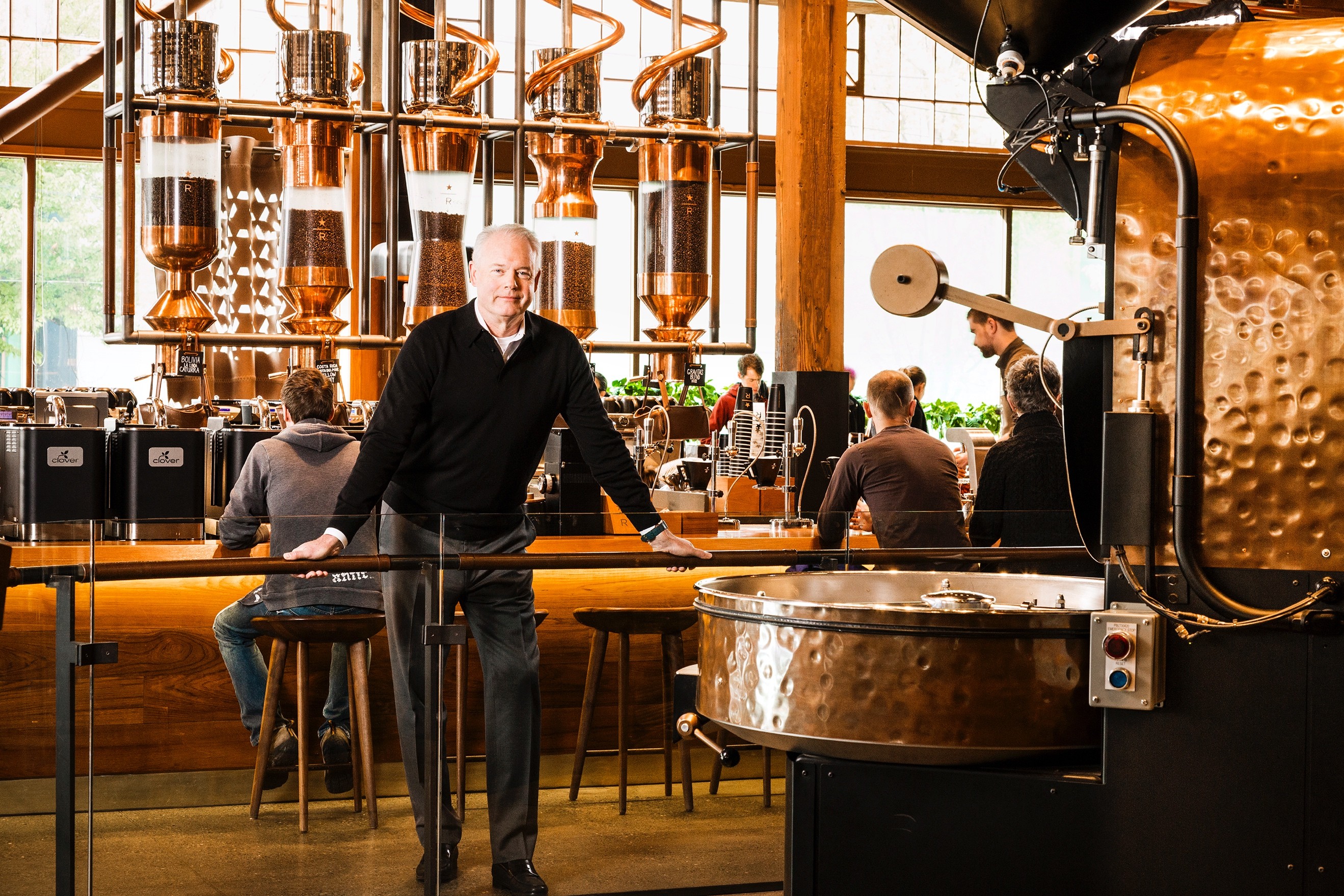
|
每年,在星巴克年度會議召開前夕,,霍華德·舒爾茨總會去一趟坐落于西雅圖派克市場的首家星巴克店面,,喝一杯雙份瑪奇朵,,并借機(jī)反思這家公司30多年來走過的風(fēng)雨歷程,。3月22日召開的年度會議,是舒爾茨第二個CEO任期的最后一次,,這個慣例由此增加了額外的分量,。他計劃搞個儀式來紀(jì)念這一時刻。 舒爾茨擬定在上午6點半到達(dá)店鋪,,但他以早起跑步而著稱,,就像一位同事所言,他遵循的是“霍華德時間”,。那些將要在這個儀式上扮演角色的員工知道,,他們需要在6點15分之前到達(dá)那里,,不然就很可能看不到他的人影。其中一位是舒爾茨欽定的CEO接班人凱文·約翰遜,。那天早上,,兩人身著襯衫和領(lǐng)帶,在擺放著一袋袋咖啡豆的店鋪小聚了幾分鐘,。舒爾茨回憶起這家咖啡店的早期歲月。 然后,,他正式向約翰遜遞交了這家咖啡店的鑰匙,。他說,近35年來,,他一直隨身攜帶著這把鑰匙,。兩人合影留念。到早上6點22分,,太陽還沒有升起的時候,,兩人就離開了?!白晕姨嵝眩翰灰谚€匙弄久了,。”在走出店門的時候,,約翰遜高聲耳語道,。 |
Every year, before Starbucks’ (sbux, -1.07%) annual meeting, Howard Schultz goes to its original store at Seattle’s Pike Place Market to drink a doppio macchiato and reflect on how far the company has come in his more than 30 years there. The most recent annual gathering on March 22 was Schultz’s last during his second run as CEO. That gave the ritual added weight, and he planned a ceremonial moment to mark the occasion. Schultz was scheduled to arrive at the store at 6:30 a.m., but he’s notorious for running early— “Howard time,” as a colleague calls it. Those playing some part knew to get there by 6:15 or risk missing him completely. One of those people was Kevin Johnson, Schultz’s chosen successor as CEO. That morning the two, both in shirt and tie, suit jackets doffed, spent a few minutes together amid the bags of beans. Schultz reminisced about the early days. Then he formally presented Johnson with the key to the original store, a possession he said he had carried in his pocket for nearly 35 years. The two posed for a photo and by 6:22, with the sun yet to rise, both were gone. “Note to self: Don’t lose the key,” Johnson stage-whispered on his way out the door. |
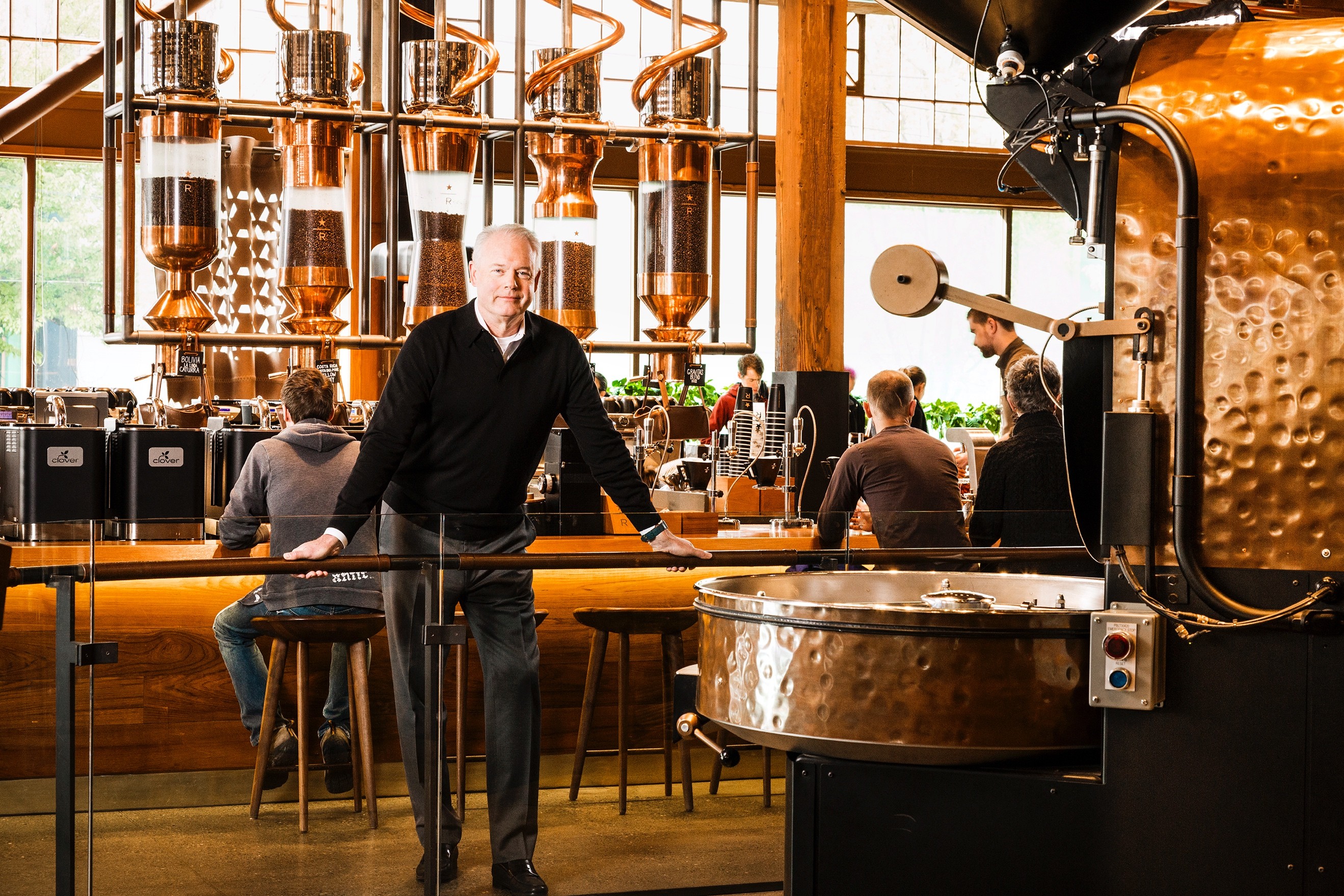
新任CEO約翰遜將依靠他的技術(shù)經(jīng)驗,專注于打造星巴克的數(shù)字訂購業(yè)務(wù)
圖片提供:Brian Smale
|
事實證明,,這位新CEO根本不用擔(dān)心,。一個半月后,在星巴克西雅圖總部辦公室,,舒爾茨對我說,,“我還有一把鑰匙?!? 還有比這更加貼切的隱喻嗎,?移交一家公司的控制權(quán),向來都是很棘手的事情,,而當(dāng)這個過程涉及到一位極具魅力,,幾乎一手創(chuàng)建這家公司的長期領(lǐng)導(dǎo)者時,其難度無疑會翻番,。4月3日,,63歲的舒爾茨正式卸任星巴克CEO一職。 就舒爾茨的例子而言,,一個不可避免的問題是,,一位以渴望獲得絕對控制權(quán)著稱的完美主義者,,將如何把他的完美主義應(yīng)用到控制權(quán)的讓渡上?考慮到他迄今為止最著名的職業(yè)失敗正是他上一次卸任CEO的嘗試——這起發(fā)生在2000年的卸任事件,,逐漸演化為一場緩慢沸騰的災(zāi)難,,最終以他的勝利回歸收場——這項挑戰(zhàn)顯得愈發(fā)嚴(yán)峻。舒爾茨真的極其渴望這一次能順利搞定,?!拔矣X得,在一位上市公司CEO必須做好的重大事務(wù)清單上,,接班人議題絕對排在前三項,。我第一次搞砸了?!彼f,。 對于舒爾茨卸任CEO,華爾街已經(jīng)表達(dá)了極其矛盾的立場:星巴克必須準(zhǔn)備迎接新一代的領(lǐng)導(dǎo)層,!霍華德,,你能否繼續(xù)堅守一段時間呢? 對于56歲的約翰遜而言,,所有這些觀點都不會讓他感到輕松,。除了接替一位商界傳奇人物之外,這位新CEO的履新時間正值星巴克的銷售額從“滾燙”轉(zhuǎn)入“微溫”之際,。作為一項關(guān)鍵指標(biāo),,同店銷售額仍然在上漲,但其增長步伐正處于金融危機(jī)以來最慢的時刻,。這家公司已經(jīng)連續(xù)五個季度未能實現(xiàn)分析師對該指標(biāo)的預(yù)期值,。 盡管如此,星巴克仍然雄心不減,。憑借去年創(chuàng)造的213億美元收入,,該公司在《財富》500強(qiáng)榜單中排名第131位。根據(jù)星巴克自己的預(yù)計,,到2021年,,其營收將增至350億美元——也就是說,該公司的營收將爆炸式增長64%,。為實現(xiàn)這一雄心勃勃的目標(biāo),,星巴克計劃在未來五年開設(shè)約1.2萬家門店,門店總數(shù)將達(dá)到3.5萬家,。大多數(shù)新店將開設(shè)在中國,。星巴克認(rèn)為,有朝一日,,中國將成為其最大的市場,。其中約3400家店面將開設(shè)在美國本土,。(相比之下,專注于墨西哥菜品的Chipotle快餐店只有大約2300家店面,。) 除了用咖啡店覆蓋這個星球之外,,星巴克還有兩大增長計劃。按照約翰遜的說法,,這是兩件“對該公司未來至關(guān)重要的大事”,。約翰遜將負(fù)責(zé)其中之一:持續(xù)推動星巴克的數(shù)字和移動業(yè)務(wù)。鑒于他曾經(jīng)在微軟擔(dān)任多年高管職位,,后來又出任電信硬件制造商Juniper Networks公司首席執(zhí)行官,,對于他來說,這是一項自然而然的使命,。在這一領(lǐng)域,星巴克已然扮演領(lǐng)導(dǎo)者的角色,,其25%的訂單現(xiàn)在采用數(shù)字方式訂購或支付,。約翰遜的任務(wù)是擴(kuò)大和燙平物流環(huán)節(jié),以創(chuàng)建一個旨在促進(jìn)速度和便利性,,不會讓客戶感到沮喪和長時間等待的系統(tǒng),。 第二個關(guān)鍵領(lǐng)域?qū)⒂墒鏍柎挠H自掛帥。作為執(zhí)行董事長,,他正在引領(lǐng)星巴克開發(fā)一個高端品牌和“體驗式目的地”,,以吸引那些放棄購物中心,轉(zhuǎn)而光臨小店的消費(fèi)者,。這項策略涉及一波三管齊下的攻勢,,其中包括(1) Roastery咖啡烘焙工坊——這是星巴克受電影《查理和巧克力工廠》啟發(fā)而建立的少數(shù)幾家大型超豪華咖啡宮殿;(2)一種被稱為Reserve甄選的稀有咖啡豆,,這是一個全新品牌,;(3) Reserve甄選咖啡門店,屬于二級精品店,,比一般的星巴克咖啡店高一級,,但沒有Roastery咖啡烘焙工坊那樣高端。如果一切順利,,這些新選項甚至有可能吸引一些以純正咖啡主義者自詡的消費(fèi)者,。這些消費(fèi)者寧愿花費(fèi)16美元,在諸如Blue Bottle這類“手工作坊”購買一杯單一產(chǎn)地咖啡,,也不愿屈尊光臨星巴克,。 此處蘊(yùn)含著潛在的沖突。舒爾茨希望繼續(xù)服務(wù)于每天光臨星巴克咖啡店的9000萬消費(fèi)者,,維系華爾街對該公司的推崇,,并獲得咖啡界的尊重,。他是一位狂熱的咖啡愛好者,這是一種非常個人化的感覺,。絕非巧合的是,,他喜歡喝雙份瑪奇朵,這種被濃郁的牛奶泡沫“染色”的傳統(tǒng)濃咖啡,,往往是那些步入羅馬咖啡館(而不是一家典型的星巴克咖啡店)的消費(fèi)者的首選,。 但他的公司之所以獲得史無前例的成功,并不是得益于仿制意大利咖啡,,而是因為它完美地適應(yīng)了美國人的口味,。正如一位小型競爭對手嘲笑的那樣,星巴克咖啡是“咖啡和牛奶的‘大口吞飲’版本”,。在星巴克服役21年的資深高管霍華德·貝哈爾透露稱,,舒爾茨最初不太愿意銷售星冰樂?!八环纤麑兛Х鹊睦斫?,”貝哈爾說。從一開始,,舒爾茨總是詢問一個問題:我們?nèi)绾翁嵘Х鹊钠焚|(zhì),?現(xiàn)如今,他正在將其作為自己的首要任務(wù),。所有這些都表明,,他不會馬上離開。 首次卸任失敗 2000年,,舒爾茨首次卸任CEO,。這個進(jìn)程起初相當(dāng)順利。他的繼任者奧林·史密斯是星巴克的老臣子,,曾在不同時期擔(dān)任首席財務(wù)官和首席運(yùn)營官,。舒爾茨對他頗為了解,信任有加,。公司業(yè)務(wù)蓬勃發(fā)展,。 五年后,在史密斯退休之后,,情況發(fā)生了變化,。到那時,吉姆·唐納德已經(jīng)接管最高權(quán)杖,。舒爾茨在2011年出版的著作《一路向前》中透露稱,,他與這位CEO的關(guān)系變得非常“復(fù)雜”。作為一位前沃爾瑪高管,,唐納德是一位局外人,,兩人經(jīng)常在一些重要的招聘決策上產(chǎn)生分歧。舒爾茨身上的“企業(yè)家病”——他無法脫離他所建立的公司——開始顯露出來,。他告訴《財富》雜志,,“我把責(zé)任放在了自己的肩頭。我不認(rèn)為我當(dāng)時像今天這樣認(rèn)識到了放手的必要性,?!? 2008年,舒爾茨重返首席執(zhí)行官崗位,。彼時,,星巴克的業(yè)績正陷于掙扎,美國經(jīng)濟(jì)急轉(zhuǎn)直下固然是一個因素,,但正如舒爾茨在一封泄露的致唐納德備忘錄中所言,,另一個重要原因是“星巴克體驗的商品化”。在回歸最高職位之后,,此前留任董事會主席一職的舒爾茨帶領(lǐng)這家咖啡連鎖巨頭擺脫頹勢,,并迎來了一段黃金發(fā)展期。舒爾茨本人也由此贏得廣泛聲譽(yù),。 這些榮譽(yù)當(dāng)然有助于提升舒爾茨本人的自我價值感,但不太利于星巴克的繼任計劃,。去年12月1日,,當(dāng)約翰遜宣布出任CEO時,該公司的股票在盤后交易中短暫下跌12%,。餐飲行業(yè)分析師約翰·佐利迪斯表示,,“投資者非常關(guān)注此事。他們非常了解霍華德·舒爾茨上一次卸任時發(fā)生的事情,?!? 舒爾茨現(xiàn)在采用了一種折衷的方式。他清楚無誤地表明,,約翰遜正在執(zhí)掌公司,,但同時暗示,真正的老大絕不會遠(yuǎn)離,?!拔乙f的是,他正在成為星巴克的首席執(zhí)行官,,但我希望你知道他將成為首席執(zhí)行官,。”在去年12月份的投資日會議上,舒爾茨在一段事先準(zhǔn)備好的發(fā)言中這樣說道,?!八麚碛凶罱K決策權(quán)。他正在運(yùn)營這家公司,?!背齼晌桓吖苈毼恢猓磩?chuàng)意,、全球設(shè)計與創(chuàng)新高級副總裁麗茲·穆勒,,以及Roastery和Reserve事業(yè)部總裁克里夫·布羅斯,舒爾茨的所有直接下屬都已經(jīng)開始向約翰遜匯報工作,。 不過,,每個人都需要調(diào)整的時間,就連舒爾茨的一些旨在鼓勵的嘗試,,也難免讓人覺得老獅子正在庇護(hù)他的繼任者,。4月27日,在約翰遜正式成為首席執(zhí)行官不到一個月之后,,他主持召開了他上任后首場分析師電話會議,,舒爾茨也在線上。 “凱文,,祝賀你的首次電話會議順利召開,。我認(rèn)為你做得很棒?!痹诩s翰遜完成業(yè)績陳述之后,,舒爾茨這樣說道。(星巴克的業(yè)績未能達(dá)到分析師的目標(biāo)值,。)他還對星巴克中國首席執(zhí)行官王靜瑛說,,“你在中國半夜參加會議,我真的為你感到驕傲,?!? 約翰遜主持管理層討論環(huán)節(jié),但在高管們回答問題之前,,他留了一段時間讓舒爾茨發(fā)言,。后者表示,他的發(fā)言“沒有稿子,,更加接近于總結(jié)陳詞,。” 舒爾茨堅持認(rèn)為,,這次領(lǐng)導(dǎo)層變更與上一次迥然不同,。一方面,,他說,約翰遜不是局外人,。在技術(shù)上,,這樣說沒錯,但還是有一定的誤導(dǎo)性,。約翰遜自2009年起擔(dān)任星巴克董事,。他此前的職業(yè)生涯基本上都是在微軟等科技公司度過的,隨后于2015年,,也就是舒爾茨的上一位當(dāng)然繼任者特羅伊·阿爾斯特德離職之后,,開始出任星巴克首席運(yùn)營官兼總裁。 一些分析師質(zhì)疑約翰遜缺乏零售經(jīng)驗,,但舒爾茨著重強(qiáng)調(diào)了他長達(dá)34年技術(shù)從業(yè)經(jīng)驗的重要性,。他承認(rèn),日益關(guān)鍵的數(shù)字業(yè)務(wù)并不是自己的“主要技能”,。 |
The new CEO need not have worried, it turns out. “I have another key,” Schultz tells me a month and a half later in his office at the company’s Seattle headquarters. Could there be a more apt metaphor? Handing over control of a company is always tricky—Schultz, 63, officially relinquished the CEO job on April 3—and doubly so when it involves a charismatic, longtime leader who all but founded the company. In Schultz’s case, how does a notorious perfectionist who craves total control apply his perfectionism to the act of ceding control? That challenge is all the more fraught because his most notorious professional failure by far was his last attempt to leave as CEO, in 2000, a slow-boiling disaster that eventually concluded with his triumphant return. Schultz really, really, really wants to nail it this time. “I would say that, of the list of the most important things that a public CEO has to get right, succession is in the top three,” he says. “I did not get it right the first time around.” For its part, Wall Street has made its position absolutely?…?contradictory: Starbucks must prepare a new generation of leadership!! And also, Howard, could you stay just a little longer?!? None of that makes it easy for Johnson, 56. In addition to replacing a legend—as he has quipped, he has venti-sized shoes to fill—the new CEO is doing so at a time when Starbucks’ sales have turned from scalding to tepid. Same-store sales, a key metric, are still rising, but at the slowest pace since the financial crisis. The company has fallen short of analysts’ expectations on that measure for five consecutive quarters. Despite that, Starbucks’ ambitions are audacious. The company recorded $21.3 billion in revenues last year, ranking it at 131 on the Fortune 500—and it’s projecting it will reach $35 billion in sales by 2021. To achieve that hoped-for 64% revenue explosion, Starbucks plans to open some 12,000 stores over the next five years, which would bring its total count to 37,000. The majority will be in China, a market the company thinks could be its biggest someday. Some 3,400 of the new stores will be in the U.S. (By comparison, Chipotle has about 2,300 in its entire system.) Beyond covering the planet with coffee bars, Starbucks has two main growth initiatives, which Johnson calls the “most critical things for the future of the company.” Johnson will be in charge of one of them: the continuing development of Starbucks’ digital and mobile operations. That’s a natural mission for him, given that he was an executive at Microsoft (msft, -0.54%) for many years and, later, CEO of telecom hardware maker Juniper Networks. Starbucks is already a leader in this realm, with 25% of orders now placed or paid digitally. Johnson’s task will be to expand and iron out the logistics so that a system made to facilitate speed and convenience doesn’t leave customers frustrated and cooling their heels. The second key area will fall to Schultz. As executive chairman, he’s leading Starbucks’ push to develop a higher-end brand and “experiential destinations” to entice people who have abandoned malls to stop by a store. That strategy involves a three-pronged attack consisting of (1) the Roastery, a handful of massive, ultraluxurious coffee palaces inspired in part by Charlie and the Chocolate Factory; (2) a new brand of rare and single-origin coffee beans called Reserve; and (3) a second line of boutiques—a notch above a regular Starbucks but not quite as over the top as the Roastery—also called Reserve. If all goes well, those options might even lure some self-styled purists who spend $16 for a cup of single-origin pour-over at an “artisanal” coffee emporium like Blue Bottle and wouldn’t deign to set foot inside a Starbucks. There’s a tension there. Schultz wants to keep serving 90 million people a day, maintain the admiration of Wall Street—and be respected by the coffee community. He’s an aficionado, and this feels personal. It’s no coincidence that his drink of choice, the double macchiato—a traditional espresso “stained” with a dash of frothy milk—is downed more often by people standing at the bar of a café in Rome than in a typical Starbucks. But his company achieved epic success not so much by emulating Italian coffee as by adapting it to American tastes, what one tiny rival derides as the “Big Gulp version of coffee and milk.” Schultz initially hesitated to sell frappuccinos, says Howard Behar, a Starbucks executive for 21 years. “It didn’t live up to his purist idea of coffee,” says Behar. Schultz has always asked one question, Behar says, since the beginning: How do we elevate the coffee? Now he’s making it his primary mission. All of which suggests he won’t be leaving anytime soon. The first time Schultz stepped aside as CEO in 2000, the process started fairly smoothly. His successor, Orin Smith, was a company veteran who had served as CFO and COO at various times. Schultz knew and trusted him. Business was booming. The circumstances changed five years later, after Smith retired. By then Jim Donald had taken over, and Schultz’s relationship with him became “complicated,” according to Schultz’s 2011 book Onward. Donald, a former Walmart (wmt, +0.48%) executive, was an outsider, and the two regularly disagreed on major hiring decisions. Schultz’s entrepreneur’s disease—his inability to detach from the company he had built—began to show itself. “I put the responsibility on myself,” he tells Fortune. “I don’t think I was prepared as I certainly am today to recognize the need to let go.” Schultz returned as chief executive in 2008 as the business struggled, owing to a combination of a spiraling economy and what Schultz, in a famous leaked memo to Donald, called the “commoditization of the Starbucks experience.” Schultz, who had retained the chairman title, returned to the CEO job and was hailed for the turnaround and the stellar run that followed. Those kinds of accolades are great for the ego but less so for succession plans. When Johnson was announced as CEO on Dec. 1, the company’s stock briefly dropped 12% in after-hours trading. “Investors are very focused on it,” says restaurant industry analyst John Zolidis. “They’re well aware of what happened the last time Howard Schultz stepped aside.” Schultz is now walking a fine line, making it clear that Johnson is running the business but signaling that the big kahuna is never far away. “I say not only that he’s becoming the CEO of Starbucks, but I want you to know he is going to be the CEO,” Schultz said during his prepared remarks at the company’s investor day in December, preempting the likely question from analysts. “He’s got the last word. He is running the company.” All of Schultz’s direct reports except for two—Liz Muller, senior vice president of creative, global design, and innovation, and Cliff Burrows, president of the group overseeing the Roastery and Reserve—have shifted to Johnson. Still, it takes time for everyone to adjust, and even Schultz’s attempts to be encouraging betrayed the faintest hint of the old lion patronizing his successor. Less than a month after Johnson officially became CEO, he hosted his first earnings call with analysts on April 27, and Schultz was on the line. “Kevin, congratulations on your first call. I think you did really well,” he said after the presentation of the company’s results, which had failed to meet analysts’ targets. Referring to Starbucks’ China CEO, Belinda Wong, Schultz added, “And, Belinda, coming from China in the middle of the night, I could not be more proud of you.” Johnson ran the management discussion but left time for Schultz—who described himself as the “unscripted closer to summarize what’s been said”—to speak before executives took questions. Schultz is adamant that this transition will be different from the last. For one thing, he says, Johnson isn’t an outsider. That’s technically true, but slightly misleading. Johnson, a company director since 2009, spent his career at Microsoft and other tech companies, then took an executive role as Starbucks’ chief operating officer and president in 2015, beginning when the last heir apparent, Troy Alstead, departed. Some analysts question Johnson’s lack of retail chops, but Schultz has stressed the importance of his experience as a 34-year tech industry veteran. This increasingly critical digital business is not Schultz’s “primary skill,” he admits. |
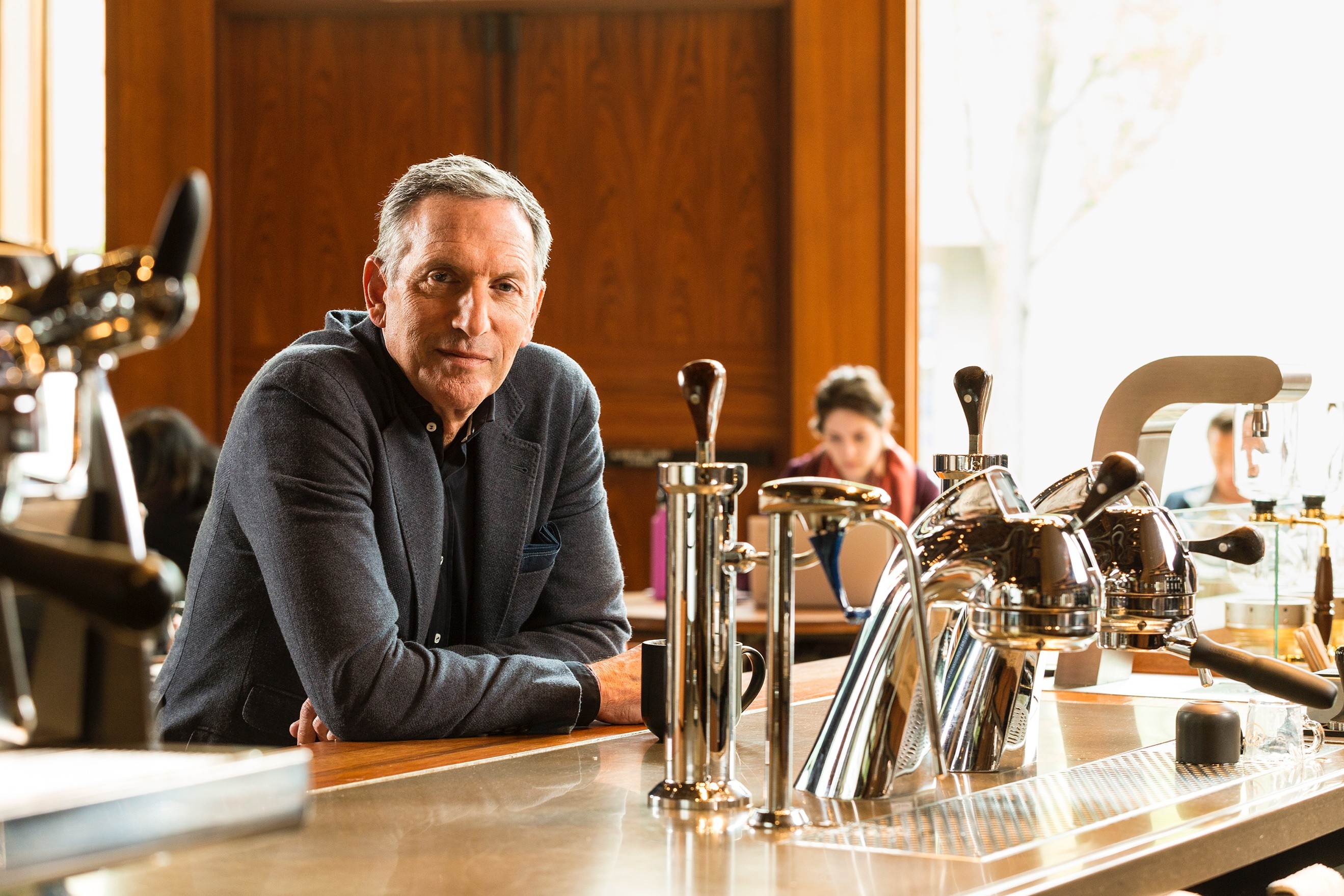
霍華德·舒爾茨在西雅圖Roastery咖啡烘焙工坊
圖片提供:Brian Smale
|
此外,,舒爾茨不僅發(fā)現(xiàn)了Roastery和Reserve品牌的潛力和重要性,也逐漸意識到了它們所需要的時間投資,?!拔业娜粘贪才艑⑴c公司的日常運(yùn)營事務(wù)嚴(yán)重沖突?!彼@樣說道,。“在私下里,,我真心相信凱文比我自己更加適合運(yùn)營星巴克的未來,。” 如果說舒爾茨就像是高管中的“雙份瑪奇朵”,,激情四射,活力十足,,那么約翰遜就是一杯“無咖啡因的香草拿鐵”,。回應(yīng)《財富》的問題時,,約翰遜顯得非常有條理——他是數(shù)字驅(qū)動型高管,,而舒爾茨則更加傾向于根據(jù)本能運(yùn)營企業(yè)——恪守標(biāo)準(zhǔn)的CEO腳本。5月份,,當(dāng)我在舒爾茨的辦公室同時采訪他們兩人時,,約翰遜花了一分半鐘仔細(xì)分析兩人不同的領(lǐng)導(dǎo)風(fēng)格,舒爾茨隨后插話說,,“凱文更安靜,,更耐心,我生來就不安分?!? 這方面的例子不勝枚舉,。比如,當(dāng)星巴克高級副總裁穆勒正在中國出差時,,舒爾茨突然要求她即刻飛回美國,,查看他此前為Roastery咖啡烘焙工坊選擇的店址。隨后,,當(dāng)穆勒在南非度假時,,舒爾茨給她打電話說,他們應(yīng)該開設(shè)更多的烘焙工坊,。 鑒于舒爾茨對細(xì)節(jié)極端苛求的關(guān)注,,他或許無法獨自執(zhí)掌一個龐大如星巴克的商業(yè)帝國。幾年前,,他開始癡迷于公司的早餐三明治,,因為他認(rèn)為燃燒奶酪(特別是切達(dá)干酪)的氣味淹沒了門店里的咖啡香氣。由于當(dāng)時的CEO是唐納德,,舒爾茨未能成功地將所有的早餐三明治從菜單中刪掉,。后來,當(dāng)他重新出任CEO的時候,,他再次著手解決這個問題,,最終制定了一系列新程序(包括將奶酪放在三明治的不同部分)以避免燃燒氣味。 星巴克高級顧問戴夫?奧爾森表示:“如果你是一個控制狂,,有兩萬家店面等著你告訴他們該怎么做,,那根本就是行不通的?!彼貞浾f,,在快速撥號時代之前的那些日子,舒爾茨竟然將大約50到70家店面的電話號碼爛熟于心,?!爱?dāng)星巴克只有那么多店面時,他的激情和干勁可以以那樣一種方式展示出來,?!? 舒爾茨對完美的不懈追求,或許在一定程度上導(dǎo)致他上一次未能完美卸任CEO,。但這一次,,這種追求或許有助于最高權(quán)杖的順利過渡。一次失敗的換班或許可歸咎于意外,;兩次失敗則會讓人覺得這是舒爾茨自己的問題,。他絕對不希望自己的職業(yè)生涯留下這樣一個難以抹去的污點,。 Roastery烘焙工坊 2009年,隨著星巴克開始重新走上正軌,,舒爾茨在一張便利貼上寫下了幾個短語:“威利·旺卡咖啡店,,”“帶顧客踏上神奇的地毯,”“完全沉浸于快樂的客戶體驗,,”“咖啡巔峰,。”舒爾茨讓這個想法不斷擴(kuò)散,,直到2012年,,他發(fā)現(xiàn)了一個他認(rèn)為堪稱完美的實驗室:一個坐落于西雅圖派克街,面積達(dá)1.5萬平方英尺的前沃爾沃汽車經(jīng)銷店,。舒爾茨邀請該公司創(chuàng)意和設(shè)計主管穆勒來他家,,和他一起觀看電影《查理和巧克力工廠》。 2014年12月,,星巴克的首家Roastery烘焙工坊——該公司的“咖啡神社”——正式起航,。實際上,這家店面確實有一些“巧克力工廠”元素,,盡管它身處一個非常優(yōu)雅的環(huán)境之中,。咖啡豆經(jīng)管道穿過烘焙過程的各個階段,,最后降落在咖啡吧,。在那里,你可以點一杯微批次咖啡,,比如佛得角福戈島或盧旺達(dá)馬拉巴,。這類咖啡采用不同于普通星巴克店面的釀造方法:錐形咖啡壺、手沖,、Clover咖啡機(jī),、法壓壺、虹吸式咖啡壺或者手工濃縮壺(普通店面使用自動機(jī)器),。Roastery烘焙工坊充滿了銅和手工染色的再生木材,。 在零售區(qū)以149.95美元價格銷售的熱水瓶,可以將你的咖啡設(shè)定在一個選定的溫度,,還有專為Roastery烘焙工坊設(shè)計的Miir McCall Cruiser自行車,配有一個可承載Cold Brew冷萃咖啡壺的貨架,,售價1499.95美元,。這些產(chǎn)品深受客戶歡迎。在Roastery烘焙工坊,,訪客平均花費(fèi)約20美元,,是普通星巴克店面的4倍左右,。 Roastery烘焙工坊實現(xiàn)了普通星巴克店面難以完成的事情:它吸引大批客戶在下午和晚間光臨店面。在Roastery,,大部分銷售發(fā)生在下午,。(該公司曾經(jīng)嘗試在400個店面銷售葡萄酒和啤酒,以推動普通星巴克店面的午后銷售額,。星巴克原計劃在數(shù)千家門店推出這項名為“Evenings”的計劃,。今年1月份,該公司發(fā)布聲明稱“暫?!绷诉@種嘗試,。) 這家公司計劃開設(shè)20家至30家Roastery烘焙工坊,在紐約,、芝加哥,、東京和上海的開店計劃已經(jīng)啟動。這些店面將烘焙星巴克高端品牌Reserve咖啡,。1000家Reserve門店也將提供Reserve咖啡,。這些門店堪稱迷你型Roastery烘焙工坊,其規(guī)模是普通門店的兩倍,。首家門店將于今年秋天在該公司總部開門營業(yè),,第二家將于2018年落戶芝加哥。Reserve門店預(yù)計將產(chǎn)生300萬美元的年銷售額,,是普通星巴克門店的兩倍,。最終,20%的星巴克店面將設(shè)置一個高端Reserve 咖啡吧,。此外,,這家公司還引入意大利手工烘焙和美食品牌Princi,為Roastery烘焙工坊和Reserve門店提供獨家食品供應(yīng),。 |
Schultz also had started to see not only the potential and importance of the Roastery and Reserve brands but the time investment they would require. “My schedule was not going to be compatible with running the company day to day,” he says. “And I had my own private moment of realizing I honestly believe that Kevin would be better suited to run the future of Starbucks than myself.” Compared with Schultz, a double macchiato of an executive—he’s intense and caffeinated—Johnson comes across as a decaf vanilla latte. (He says he favors a triple macchiato.) Johnson is methodical in his responses—he’s data-driven, whereas Schultz tends to operate more on instinct—and hews to a standard CEO script. When I interviewed the duo together in Schultz’s office in May, Johnson gave a careful minute-and-a-half analysis of their differing leadership styles before Schultz jumped in. “Kevin is calmer, more patient,” Schultz says. “I was born restless.” One of countless examples: Starbucks’ SVP Muller was on a trip to China when Schultz wanted her to fly back right away to look at the site he had found for the Seattle Roastery. He then called her while she was on vacation in South Africa to tell her they should open more. Starbucks had perhaps gotten too big for Schultz to run alone, given his exacting attention to detail. Years ago he became obsessed with the company’s breakfast sandwiches because he thought the odor of burning cheese—in particular cheddar—overwhelmed the coffee aromas in the store. While Donald was CEO, Schultz pushed unsuccessfully to remove all breakfast sandwiches from the menu. Then, when he returned as CEO, he again took up the issue, ultimately instituting a series of new procedures (including placing the cheese in a different part of the sandwich) to avoid burning it. “If you’re a control freak and there’s 20,000 stores waiting for you to tell them what to do, it’s not going to work,” says Dave Olsen, a senior adviser to Starbucks. He recalls that in the days before speed dial, Schultz had some 50 to 70 store phone numbers memorized. “His passion, his intense drive, all of that could play out in that way when there were that many stores.” Schultz’s quest for perfection, which may have been part of the problem during the last CEO handoff, just might help the transition this time around. One failed changeover could be chalked up to a fluke; two makes it look like Schultz’s problem. That’s not a mark that he wants on his record. In 2009, as Starbucks’ turnaround was underway, Schultz jotted a few phrases on a Post-it: “the Willy Wonka of coffee,” “take customers on a magical carpet ride,” “totally immersive joyful customer experience,” “coffee at its peak.” Schultz let the idea percolate until 2012, when he found what he believed to be the perfect laboratory: a 15,000-square-foot onetime -Volvo dealership on Pike Street in Seattle. Schultz had Muller, the company’s head of creative and design, come over to his house to watch Charlie and the Chocolate Factory with him. Starbucks opened the Roastery, its “coffee shrine,” in December 2014, and indeed it has some “chocolate factory” touches, albeit in a much more elegant setting. Tubes shoot coffee beans through stages of the roasting process before they land at the coffee bar. There you can order a micro-lot like Cape Verde Fogo Island or Rwanda Maraba, brewed using methods not available in a typical Starbucks: Chemex, pour-over, a high-tech Clover brewer, French press, siphon, or manual espresso (the regular stores use automatic machines). The Roastery is filled with copper and hand-stained, reclaimed wood. The retail section sells items like thermoses that set your coffee to a selected temperature for $149.95, or a Miir McCall Cruiser bike designed exclusively for the Roastery, complete with a carrier for your cold-brew growler, for $1,499.95. Customers have spent accordingly. The average visitor spends about $20 at the Roastery, about four times the outlay at the typical Starbucks. The Roastery achieves something that few regular Starbucks can accomplish: It attracts significant clientele during the afternoon and evening. At the Roastery, the majority of sales occur in the afternoon. (The company has tried in the past to boost later-day sales at regular Starbucks, by selling wine and beer at 400 locations as part of its “Evenings” program, which was supposed to launch in thousands of stores over time. The company says it “paused” the endeavor in many stores in January.) The company plans to open 20 to 30 Roastery locations, with projects underway in New York, Chicago, Tokyo, and Shanghai. These sites will roast coffee for Starbucks’ premium Reserve brand, which will also be served in 1,000 Reserve stores—essentially mini-Roasteries that are twice the size of a typical Starbucks. The first will open inside the company’s headquarters in the fall, with the second planned for Chicago in 2018. Reserve stores are expected to generate $3 million in annual sales, twice that of the typical Starbucks. Eventually 20% of Starbucks will have a high-end Reserve bar. The company is also upping its food game for the Roastery and Reserve cafés with its investment in Italian luxury baker Princi. |
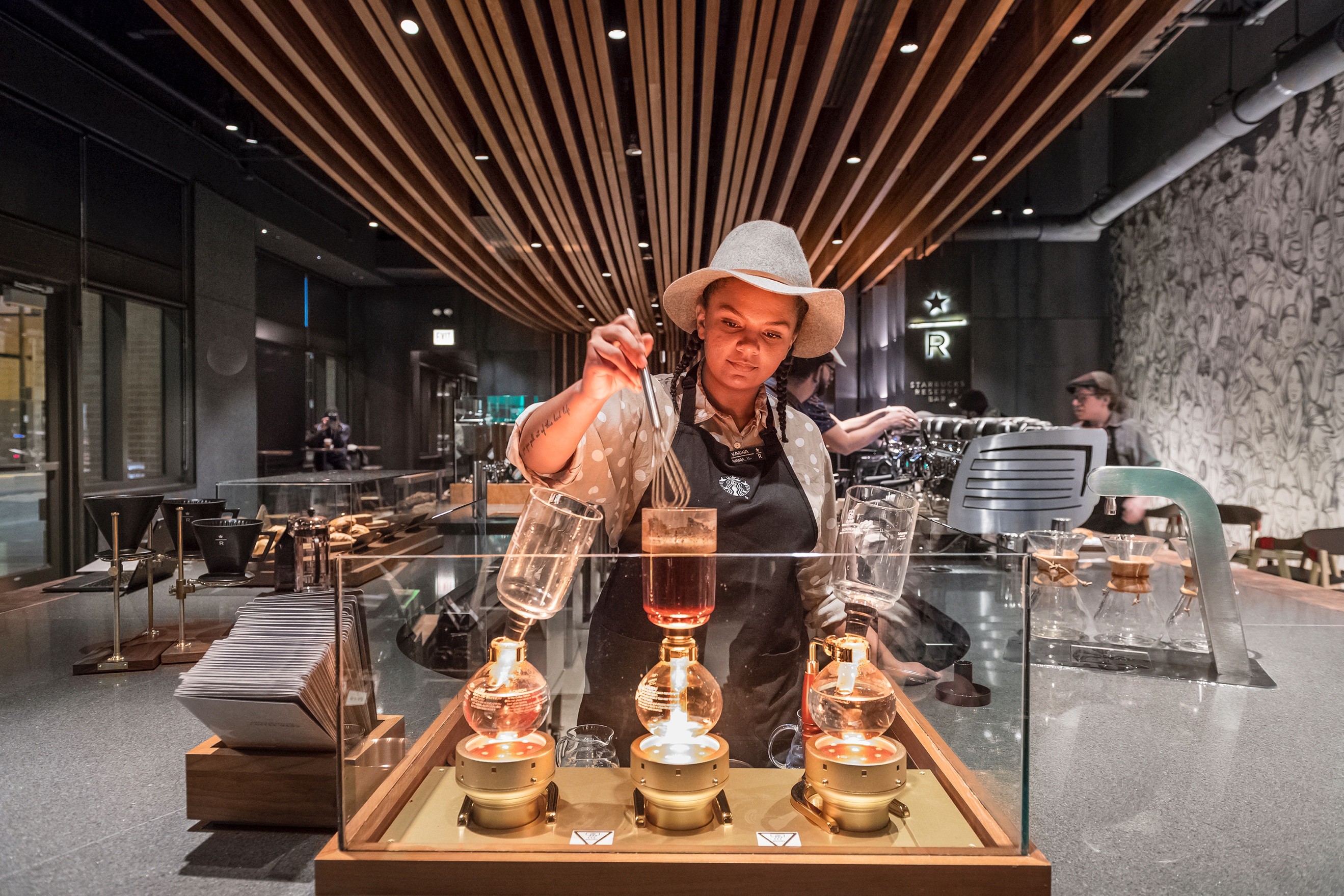
在一家設(shè)有Reserve咖啡吧的星巴克,,一位員工使用虹吸式咖啡壺釀制咖啡
圖片提供:Courtesy of Starbucks
|
這些項目旨在吸引客戶:一趟咖啡航班的試味套餐,或者虹吸式咖啡壺下的燈泡閃爍的光芒,。該公司意識到它無法繼續(xù)依賴購物中心來吸引消費(fèi)者漫步到星巴克,。隨著數(shù)以百萬的客戶放棄親身購物,涌向在線商場,,星巴克需要依靠自身力量來吸引他們,。 Roastery 和Reserve計劃,也是星巴克為抵擋高端咖啡店日益激烈的競爭壓力而做出的嘗試,。西北大學(xué)凱洛格管理學(xué)院營銷教授蒂姆?卡爾金斯表示:“星巴克不得不設(shè)法應(yīng)對一個似乎變得更像啤酒的咖啡市場,。在啤酒市場,小型精釀啤酒商紛紛合并,,正在成為一股強(qiáng)大的力量,?!? 第三波浪潮 在長達(dá)數(shù)十年的時間里,美國的餐廳咖啡幾乎普遍含水,,微咸,。所以當(dāng)星巴克從20世紀(jì)90年代開始,以更濃郁,、更深暗的烘焙和拿鐵咖啡沖擊整個國家時,,那儼然是一場咖啡革命。這些產(chǎn)品帶有濃厚的異國情調(diào),,1993年報道星巴克在東海岸的擴(kuò)張時,,《紐約時報》甚至覺得有必要解釋“拿鐵”一詞的發(fā)音。不久以后,,星巴克就成長為一個觸角遍及全球的怪獸,。許多人認(rèn)為,在某些方面,,這種大規(guī)模推出的產(chǎn)品與麥當(dāng)勞頗為相似,。 近年來,被稱為“第三波浪潮”的小咖啡供應(yīng)商迅速崛起,,這是一場排斥星巴克,,擁抱更廣泛食品類別的運(yùn)動,推崇純潔,、真實性等理念,,以及“了解你的農(nóng)戶”哲學(xué)。如果星巴克是你喝南瓜香料拿鐵的地方,,那么“第三波浪潮”就是你品嘗單品咖啡的地方,。(黑咖啡,不加糖,,謝謝,。) 像Stumptown和Blue Bottle這類更新、更酷的連鎖店,,目前或許不足以搶占市場份額,,但其中一些正在合并,并且獲得了顯著的資金支持,。比如,,投資基金JAB控股公司已經(jīng)收購了包括Peet’s在內(nèi)的多家咖啡公司,Peet’s反過來又收購了Stumptown咖啡,,并購買了Intelligentsia的股份,。 |
These projects are designed to engage the customer: a tasting menu of coffee flights or the glow of the bright bulb under the siphon brewer. The company realizes it no longer can count on malls to attract shoppers who then wander into Starbucks. With millions of customers abandoning in-person shopping and flocking online, Starbucks needs to draw them on its own. The Roastery and Reserve initiatives are also an attempt to head off rising competition from high-end coffee shops. Says Tim Calkins, a professor of marketing at Northwestern’s Kellogg School of Management: “Starbucks is going to have to figure out how you navigate a market that seems to be becoming a little bit more like beer—small crafty players merging and becoming a big force.” There were many decades when restaurant coffee in the U.S. was almost universally watery and brackish. So when Starbucks stormed the nation beginning in the 1990s with its richer, darker roasts and its lattes, it was a coffee revolution. The offerings were exotic enough that when the New York Times reported on the company’s East Coast expansion in 1993 it felt the need to explain how to pronounce the word “l(fā)atte.” (LAH-tay, for the record.) Before long, Starbucks was a global behemoth, with mass-scale products that earned it comparisons to McDonald’s in some quarters. What’s known as the “Third Wave” of small coffee purveyors then emerged in recent years as a rejection of Starbucks and an embrace of the broader food movement that reveres ideals like purity, authenticity, and a know-your-farmer philosophy. If Starbucks is where you go for a Pumpkin Spice Latte, the Third Wave shops are where you go to get your single-origin brew (black, please, no sugar) from a specific region. These newer and cooler chains like Stumptown and Blue Bottle may not be big enough to take market share, though some of them are consolidating and gaining substantial backing. Investment fund JAB Holding, for example, has rolled up a number of coffee companies, including Peet’s, which in turn has purchased Stumptown Coffee and a stake in Intelligentsia. |
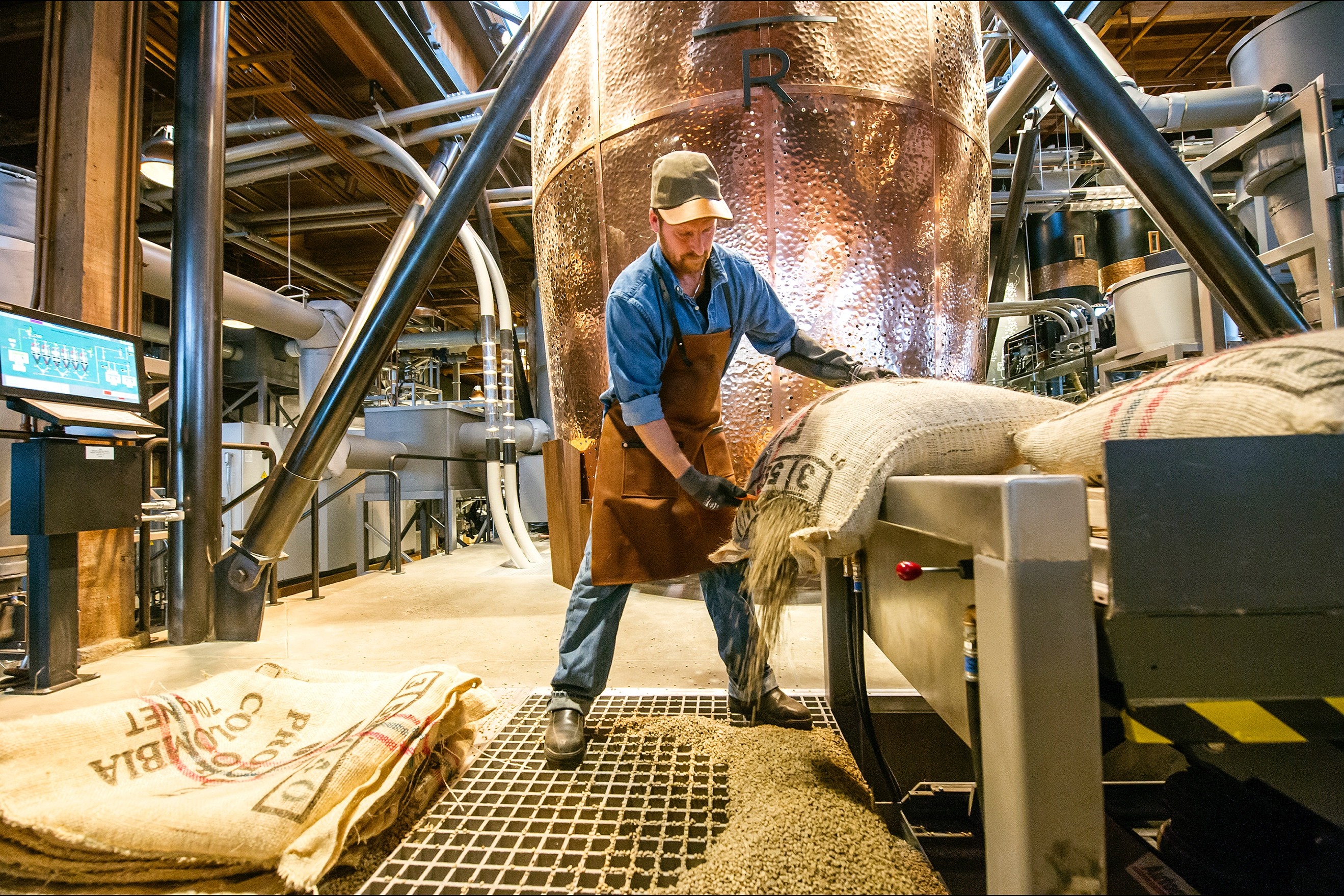
一名工人在Roastery烘焙工坊的預(yù)備區(qū)倒咖啡豆。這些咖啡豆將經(jīng)過管道涌入烘焙機(jī),然后在后面的銅桶中冷卻
圖片提供:Courtesy of Starbucks
|
但是,,這些“小魚小蝦”正在像昔日的星巴克那樣,推動消費(fèi)者的口味和習(xí)慣更加高檔化,。全美咖啡協(xié)會在其調(diào)查中首次發(fā)現(xiàn),,超過一半的咖啡消費(fèi)者將前一天喝的咖啡列為美食。 到目前為止,,對于被納入美食類別的星巴克來說,,這還不是真正的問題,因為它已經(jīng)經(jīng)歷了足夠的增長,。但活力越來越多地來自冷萃咖啡和氮氣咖啡(一種被注入氮氣的咖啡),。這兩種咖啡一直受惠于年輕的小批量生產(chǎn)商的推廣。星巴克被迫扮演追趕者的角色,。(Roastery烘焙工坊的一大潛在好處是:店面較少,,可以進(jìn)行實驗,當(dāng)該公司意識到Roastery烘焙工坊每天能夠售出100杯氮氣咖啡時,,它決定將這種飲品推廣至普通的星巴克門店,。)卡爾金斯教授表示,“星巴克面臨失去高端咖啡美譽(yù)之風(fēng)險,。有人會說,,它已經(jīng)失去了?!? 一個跡象表明時代已經(jīng)改變:小店面不再像過去那樣害怕星巴克,。幾位獨立創(chuàng)始人告訴我,大約10年前,,他們不敢夢想在一家星巴克附近開店?,F(xiàn)在,他們相信,,他們和星巴克不再是同一個客戶的競爭對手,。 星巴克熱切地關(guān)注市場新人。白鴿咖啡烘焙店創(chuàng)始人托德·卡邁克爾表示,,星巴克研發(fā)團(tuán)隊成員已經(jīng)訂購了其瓶裝拿鐵咖啡,。星巴克甚至在西雅圖開設(shè)了自己的“隱形”第三波浪潮店面。在羅伊街的店面,,你可以從一位穿著法蘭絨衣服(而不是綠色圍裙)的咖啡師那里點一杯薰衣草咖啡,。該公司還對“信譽(yù)提示”進(jìn)行了一番研究,發(fā)現(xiàn)有紋身的咖啡師被認(rèn)為會制作更好的咖啡,。 因此,,盡管它似乎極具吸引力,但Roastery烘焙工坊似乎是一種防御措施,,此舉正招致第三波浪潮咖啡店的嘲諷,?!八麄冏屑?xì)端詳每一家高端咖啡吧正在做的事情,然后逐一模仿,?!蹦壳霸诔鮿?chuàng)連鎖店Locol運(yùn)營咖啡項目的資深從業(yè)者托尼·康奈克尼如是說?!拔业挠∠笫?,在高端咖啡吧正在推動一場如火如荼的新革命之際,感到星巴克自身并沒有失去高地,,對于霍華德來說是很重要的,。” 不過,,霍華德·舒爾茨的意志力不應(yīng)該被低估,。曾在2009年出版《除了咖啡以外的一切:在星巴克讀懂美國》一書的天普大學(xué)歷史教授布萊恩特·西蒙表示,舒爾茨的決心是該公司取得如此輝煌成功的原因之一,。他不愿相信公司不再處于前沿,。許多人將星巴克與麥當(dāng)勞相提并論,這讓舒爾茨相當(dāng)生氣,?!斑@就是阻止他們墜入低端的因素。舒爾茨自己對該品牌的愿景足以讓他們停留在那里,?!蔽髅烧J(rèn)為,對于舒爾茨來說,,Roastery和Reserve品牌“將在某種程度上滿足一種做新東西,,并重振其合法性的渴望。然后,,運(yùn)營端將構(gòu)想一個新的獨角獸,。”比如,,該公司在4月份提供了一款帶有變色效果的星冰樂,。史密斯把這種張力稱為“一個完美的星巴克時刻?!彼f,,“這是一場在星巴克持續(xù)了15年之久的戰(zhàn)役?!? 當(dāng)約翰遜和舒爾茨被問及此事時,,約翰遜回應(yīng)說,星巴克的核心業(yè)務(wù)是提供一個以咖啡和人為主題,溫暖且熱情的體驗,。幾分鐘后,,舒爾茨插話進(jìn)來,他想回到這一要點,?!霸谛前涂嗽~典中,獨角獸星冰樂是一種現(xiàn)象,,”他說?!拔覀兯赖氖?,如果我們創(chuàng)造出一款可視化,可以像病毒般傳播的產(chǎn)品,,那將對我們的品牌起到增值作用,,哪怕它是高度放縱的?!?他繼續(xù)說道:“它帶有催化作用,,能增加讓人微笑的愉悅感。那怎么會是壞事呢,?我認(rèn)為長遠(yuǎn)的答案是,,如果我們要做這樣的事情,我們也必須重新確定我們在咖啡的所有精華領(lǐng)域的領(lǐng)導(dǎo)地位,。此處的紀(jì)律性在于可能性的藝術(shù),,以及“和”的力量。很長時間以來,,我們一直很擅長此道,。” 重返意大利 作為意大利的金融和時裝設(shè)計之都,,米蘭在星巴克的誕生故事中扮演著中心角色,。1983年,時任公司營銷主管的舒爾茨前往意大利參加一個行業(yè)展覽,。在此期間,,他發(fā)現(xiàn)了這座城市的濃咖啡店。在彼時的美國,,這個概念,,即一個主要銷售咖啡的店面,幾乎是不存在的,。當(dāng)時僅有四家店面的星巴克,,基本上就是一家咖啡烘焙商。回到美國后,,舒爾茨向他的老板們兜售基于米蘭咖啡吧的形象,,重建這家公司的理念。他們并不感興趣,。所以,,舒爾茨離開星巴克,創(chuàng)建了一家以米蘭日報《Il Giornale》命名的公司,。當(dāng)星巴克于1987年上市時,,舒爾茨從投資者那里籌集了380萬美元,將其收購,。 對于舒爾茨來說,,把意大利的咖啡文化帶到美國,是不夠的,;他總是夢想著將星巴克帶到意大利,。早在1998年,他就開始懷抱這樣的夢想,。他告訴《紐約客》雜志,,在意大利開店猶如“攀登珠穆朗瑪峰”。他當(dāng)時說,,他至少會等待一年時間,,才會采取這一步驟。最終,,他等待了近20年,。星巴克在2月份宣布,首家意大利店面將是一家坐落于米蘭老中央郵政大樓的Roastery烘培工坊,,計劃在2018年開門營業(yè),,隨后將開設(shè)普通的星巴克店面。 星巴克已經(jīng)征服了歐洲大部分地區(qū),,但遲遲沒有進(jìn)入意大利,,在某種程度上恰恰是對該國獨特的咖啡文化做出的反應(yīng)。在擁有大約15萬咖啡店的意大利,,人們基本上喝的是濃咖啡,。安德烈·伊利在一家以其姓氏命名的意大利公司擔(dān)任總裁。他說,,在意大利,,咖啡被當(dāng)做一種濃縮物來消費(fèi),而不是一種熱飲,?!八且环N你為生理特性而喝的東西,,它不是滿足你味蕾的飲品,它是一種萬能藥,?!? 如果你想暴露自己的游客身份,你只需要在午后點一杯卡布奇諾咖啡,?!拔绮秃竽悴粦?yīng)該喝牛奶?!币獯罄鸕oastery烘培工坊顧問,,時尚圈資深人士葆拉·巴伊這樣說道?!斑@太瘋狂了,。” 目前定居倫敦的米蘭人巴伊帶我參觀這座城市的幾家咖啡吧,,其中包括包括Marchesi和Cova。作為這些咖啡店承載著重要文化意義的佐證,,普拉達(dá)集團(tuán)和路易威登集團(tuán)最近相繼投資這些咖啡品牌,。巴伊認(rèn)為,星巴克將在米蘭交出一份出彩的成績單,;米蘭人將在星巴克品嘗星冰樂,,以及其他進(jìn)口自美國,他們在意大利咖啡店享受不到的新奇飲品,。 星巴克在意大利開店,,就此勾勒出一個奇怪的圓圈:該公司在米蘭找到靈感,將其美國化,,現(xiàn)在致力于將其美國化版本重新帶回這座城市,。曾經(jīng)在星巴克供職20年的早期高管克里斯蒂安·戴表示,舒爾茨“對舒適怡人,,帶給人真實體驗的意大利咖啡店懷有很深的感情,,但增長的挑戰(zhàn)使得這家公司以新產(chǎn)品的創(chuàng)新(而不是意大利咖啡店)而聞名?!焙喍灾?,倘若要在一個人的墓碑上勾勒一杯永恒不朽的咖啡,以示緬懷,,舒爾茨無疑會要求一杯瑪奇朵,。但歷史很可能將給他分配一杯星冰樂。(財富中文網(wǎng))??? 譯者:Kevin |
But already, these smaller fry are moving consumers’ tastes and habits more upscale in the way Starbucks once did. For the first time in the history of its survey, the National Coffee Association found that more than half of the coffee consumers reported drinking in the past day was classified as gourmet. So far, that’s not a real problem for Starbucks, which is included in the gourmet category, because there’s been enough growth to go around. But increasingly, dynamism is coming from offerings like cold-brew coffee and nitro (coffee infused with nitrogen), both of which have been popularized by the younger, small-batch operations. Starbucks has been forced to try to catch up. (One potential benefit of the Roastery: The shops are less regimented and can experiment. When the company realized it was serving 100 cups of nitro in the Roastery every day, it decided to roll the drink out to regular Starbucks.) “It’s at risk of losing the credentials of very premium coffee,” says Calkins. “Some would say it’s already lost a lot of its credentials.” One indication that times have changed: The small shops fear Starbucks less than they once did. A decade or so ago they wouldn’t have dreamed of opening near a Starbucks, several independent founders told me. Now they believe they’re no longer competing for the same clientele. Starbucks keeps a keen eye on the newbies. Todd Carmichael, a founder of La -Colombe Coffee Roasters, says members of Starbucks’ R&D team have ordered cases of its canned draft latte. Starbucks even opened its own “stealth” Third Wave shops in Seattle. At its Roy Street store you can order a lavender cortado from a barista who’s wearing flannel rather than a green apron. The company has conducted research on “credibility cues”—a bit like taking a class on authenticity—and discovered that baristas with tattoos are thought to make better coffee. And thus the Roastery, as appealing as it is, seems like a defensive move, one that is producing derision among the Third Wavers. “They looked at what every high-end coffee bar is doing and checked all the boxes,” says Tony Konecny, a longtime coffee guy who’s now running the coffee program at startup chain Locol. “The impression that I get is that it’s important for Howard to feel like they weren’t losing the high ground with all this revolution that’s happening in high-end coffee bars.” Still, the force of Howard Schultz’s will should not be underestimated. Bryant Simon, a Temple University history professor who wrote a 2009 book called Everything but the Coffee: Learning About America From Starbucks, says Schultz’s resolve is one reason the company has been so successful. He is unwilling to believe that the company is no longer cutting-edge. Simon says Schultz was apoplectic when people compared Starbucks to McDonald’s. “That’s what keeps them from falling below the middle,” he says. “His own aspirational vision for the brand is enough to keep them there.” The Roastery and the Reserve brand, Simon thinks, “will satisfy in some ways for Schultz a yearning for doing something new and reinvigorating its legitimacy. Then someone in operations will come up with a new Unicorn”—the viral, color-changing neon frappuccino, which the company offered for a week in April. Smith calls this tension a “perfect Starbucks moment.” As he puts it, “It’s a battle that’s been going on at Starbucks for 15 years.” When Johnson and Schultz are asked about it, Johnson responds by describing Starbucks’ core business as delivering a warm, welcoming experience that’s about coffee and people. The conversation moves on, but a few minutes later Schultz interjects and wants to go back to that point. “The Unicorn frappuccino was a phenomenon in the lexicon of Starbucks,” he says. “What we knew going in was that if we created a product that had the viral nature of being Instagrammable, that it would be accretive to the brand even though it was highly indulgent.” He goes on: “It was catalytic and accretive to the joyfulness of making people smile. And how could that be a bad thing? I think the long answer is that metaphorically, if we’re going to do things like that, we also have to make deposits in reaffirming our leadership position in all things that are in the essence of coffee. The discipline of that is in the art of the possible and the power of ‘a(chǎn)nd.’ And we’ve been good at that for a long time.” Milan, the financial and design hub of Italy, plays a central role in the Starbucks creation story. Schultz was working as head of marketing for the company in 1983 when he traveled to Italy for a trade show and discovered the city’s espresso bars. The concept—a place where coffee was the main event—barely existed at the time in the U.S. Starbucks, with its four stores, was primarily a coffee roaster. Schultz went home and pitched to his bosses the idea of re-creating the company in the image of the Milanese coffee bars. They didn’t bite, so Schultz left to start his own—Il Giornale, named after Milan’s daily newspaper. When Starbucks went on the market in 1987, Schultz pulled together $3.8 million from investors and bought it. Bringing Italian coffee culture to the U.S. was not enough for Schultz; he always dreamed of bringing Starbucks to Italy. As early as 1998 he had it in his sights, telling The New Yorker that to open in the country would be “to climb Mount Everest.” At the time he said it would be at least a year before he made his move. In the end it was closer to 20. The company announced in February that its first location in Italy will be a Roastery in Milan’s old central post office building. It’s scheduled to open in 2018, to be followed by regular Starbucks branches. Starbucks has conquered most of Europe, but the delay in entering Italy is partly a reaction to the country’s unique coffee culture. Italians drink most of their coffee in the form of espresso—a quick shot that just coats the mouth—while standing at the bar in one of the country’s 150,000 cafés. Andrea Illy, president of the Italian company that bears his family’s name, says that in Italy coffee is consumed as a tiny concentrate, not a hot beverage. “It’s something you drink for physiological properties,” he says. “It doesn’t feed you. It’s an elixir.” If you want to give yourself away as a tourist, order a cappuccino in the afternoon. “You’re not supposed to drink milk after lunch,” says Paola Bay, a fashion industry veteran who is advising Starbucks on the Roastery here. “That would be madness.” Bay, a Milan native who now lives in London, takes me to a few of the city’s coffee bars, including Marchesi and Cova. As a sign of how important they are culturally, the Prada Group and LVMH recently invested in the brands. Bay thinks Starbucks will do well in Milan, that the Milanese will order frappuccinos and other novelties exported from the U.S. that they can’t get at an Italian coffee bar. This is the strange full circle of Starbucks opening in Italy: The company found inspiration in Milan, Americanized it, and is now bringing its Americanized version back to the city. Schultz had “a deep passion for that intimate Italian coffee shop, that authentic experience,” says Christine Day, an early company executive who stayed for two decades, “but the challenge of growth led the company to become known for the innovation of new products, not the Italian coffee shop.” In short, if it were possible to memorialize a person with an eternal cup of coffee on his tombstone, Schultz would no doubt request a macchiato. But history will likely assign him a frappuccino. A version of this article appears in the June 15, 2017 issue of Fortune. We’ve included affiliate links in this article. Click here to learn what those are. |













